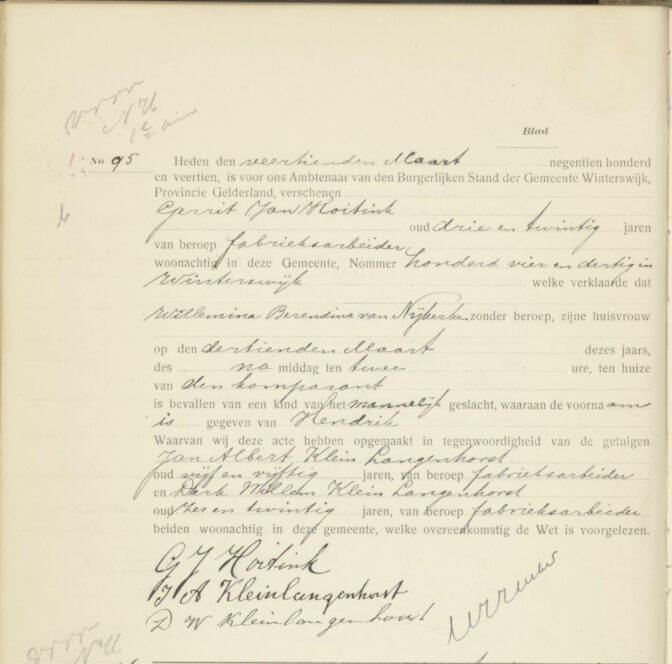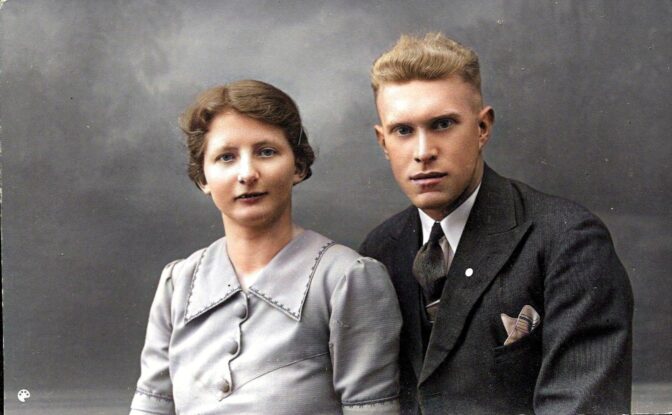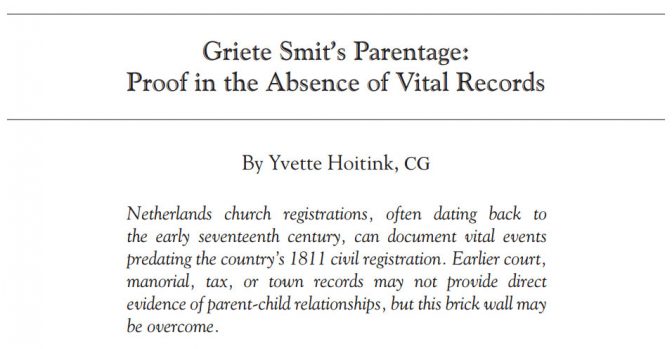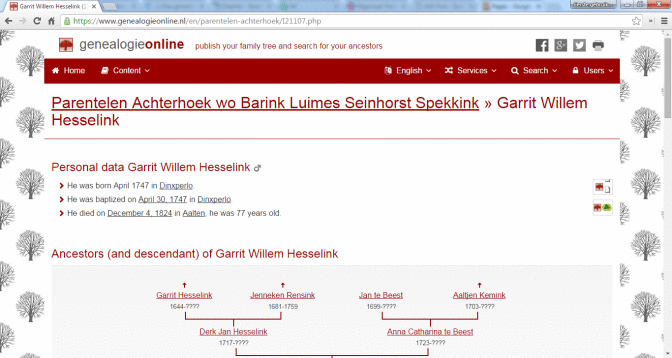In the Facebook group Goeree-Overflakkee History, Genealogy, and DNA, Rene Luijkenaar asked me a question: What can be counted as a source? Can an online tree be counted as a source? I thought I would answer in a blog post, since I know other people have the same questions.
Sources are containers of information. There are three types of sources: original, derivative, and authored. I will discuss each type, with examples from the Netherlands.
Original source
An original source is the first recorded version of a source. Examples of original sources are:
- Scans of a civil registration birth record.
- A notarial record in a bound volume.
- A microfilmed baptismal record.
- A letter written by an emigrant to family back home.
- A photograph in a family album.

Birth record of Hendrik Hoitink
Just because a source is original, does not mean it is correct. The informant of the record may have given incorrect information, perhaps because they did not know better, or because they had a reason to lie or present the facts more favorably. For example, an informant of a death record may have known exactly when a person died, but may not have known their exact age or the names of their parents.
In general, original records created close to the event are more reliable than records created later, and information provided by eye witnesses is more reliable than information provided by people who heard it from someone else.
Derivative source
A derivative source is a different version of a source, created by transcribing, abstracting, translating, or reproducing it with alterations. It may have copy or interpretation errors, for example if the compiler of the derivative source misread or misunderstood the original. Examples of derivative sources are:
- An index entry for a marriage record in WieWasWie.
- A PDF with a transcription of a serf register at Genealogiedomein.
- Scans of a handwritten transcription of a church book at Archief Tholen.
- A transcription of a newspaper created by Optical Character Recognition technology at Delpher.
- A transcription of a record of the West India Company created by Handwritten Text Recognition technology at Zoek In Transcripties.
- An abstract of a notarial record in Archieven.nl.
- A translation of a Latin charter at the digital charter book of Noord-Brabant.
- A reconstruction of a medieval text that combines different partially surviving copies.
- A colorized version of a family photo that was originally in black-and-white, created with the color tools at MyHeritage.

Engagement photo of Henk Hoitink and Mien Woordes, colorized version
Derivative sources are typically used as an intermediate step in a research project. Transcriptions, indexes, abstracts, and translations are often searchable and allow us to efficiently locate relevant records. Where available, we then consult the original records to verify the information in the derivative. Often, the original record provides more information, or has a larger context (other pages in the book, for example) that is helpful. In some cases, like the transcribed church records of Tholen, the original records may have been lost and the derivative source is the best quality information that survives.
Derivative sources are also helpful for statistical analysis, to understand how our ancestor’s situation related to others. For example, we can use a database with indexed civil registration records to see how many other people died in the town that year, and if that was unusually high compared to other years, to see if there may have been an epidemic.
Authored narrative
An authored narrative is a written source that combines information from other sources. It may have copy or interpretation errors. Authors may have unsound assumptions and may have combined information incorrectly, for example assuming that a birth and marriage record of a same-named person related to the same person. Examples of authored narratives are:
- A book with the compiled genealogy of a family.
- An article presenting a case study solving a genealogical problem, such as my case study about the parents of Griete Smith that was published in the National Genealogical Society Quarterly.
- A research report with the results of a body of research, including conclusions about kinship. A research report would typically contain derivative sources (abstracts, transcriptions) or original sources (images of original records) as well.
- An online tree, like the trees at GenealogieOnline.

The quality of authored narratives varies widely. It depends on the researcher’s skills, the researcher’s access to source materials, and the choices made in publication or compilation. For example, a book or article that does not include sources is less reliable because the reader cannot see what the quality of the underlying sources and research has been. Authored narratives can be published or unpublished.
Like derivative sources, authored narratives are often used as an intermediate step in the research process; especially if it does not appear to be of high quality. An undocumented online tree is treated with more suspicion than a case study in a peer-reviewed journal, for example. But no author is perfect, and our own research may have found evidence that overturns previous conclusions. So we will verify the research by going back to the underlying records, not only to see if they exist, but also to see if the conclusions the author drew are valid.
Is an online tree a source? Should we use it?
Now back to Rene’s original question: is an online tree a source? As you can see from the list above, it is a source; an authored narrative. But it is not a source to be trusted blindly. It should be followed up by going back to the original records to verify the author’s conclusions.
For more information using online trees as sources, see my article What is Genealogie Online?



Well done. Online trees can be radically wrong. One tree I discovered showed my van Wijk ancestor had left his birthplace in the Netherlands, moved to South Africa and fathered 3 children — all by the time he was 5 years old.
Very precocious child! Reminds me of a family member who found out her parents married three months before she was born and then said “I must have been born prematurely.”
Great article –Appreciated your comment on going back to original records, and I want to add when looking at a tree on Ancestry and Familysearch.org I have found so much information by actually looking at what they sourced for a family. Sometimes you find a census with the name completely misspelled (correct people), because the researcher went through the area census where they knew where their relatives live and knew neighbors, etc. I have done this when families some how were not on the index, but are on the actual document–sourced it, etc. So using dates and names other people have used in online trees is VERY HELPFUL. When I find terrible mistakes on trees, I send notes to explain the mistake and why and have received many great “thank yous.” I hate to have bad and wrong information being copied and copied, until people are convinced it is correct. I really want that removed from trees. On Familysearch I would remove my grandmother being the daughter of wrong parents and in the wrong country. The next week someone would add it again, so I finally researched those wrong parents and added the correct children and spouses and pictures of the documents to those wrong parents and that has worked and no one is changing it.
Good on you Lucy – I used to do that as well, but it turned out to be the biggest chore sometimes when the incorrect information had already been copied hundreds of times – and then people get confused as to who and what is correct. I will still do it if I have an ‘original’ source to give them as evidence. But I once wasted a whole afternoon on this and decided to only do it when I have hours to waste (not often). It’s a bit like dust, cockroaches and flies etc – you can correct or remove the problem/issue etc, but there are always more the next day and these days it escalates faster than a COVID virus. I love this hobby but I hate the mistakes. For myself, I try and get a source with everything – and if I ever get an ‘original’ source in the future, I change it to that if my other source was not so sure.